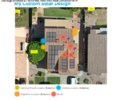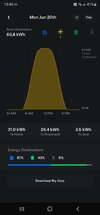Hello everyone,
I just had a 13.2 kW solar panel system installed in my home in New Jersey. On the brightest day with the sun at 90 degrees from the panels, the best I can get is just above 10 kW (and that rare). Most of the time in the 9's.
I just wanted to see if anyone else has had the same experiences with their solar.
I assumed I would get close to 13.2 in the summer with direct sun
Thanks in advance!
Russ
I just had a 13.2 kW solar panel system installed in my home in New Jersey. On the brightest day with the sun at 90 degrees from the panels, the best I can get is just above 10 kW (and that rare). Most of the time in the 9's.
I just wanted to see if anyone else has had the same experiences with their solar.
I assumed I would get close to 13.2 in the summer with direct sun
Thanks in advance!
Russ




